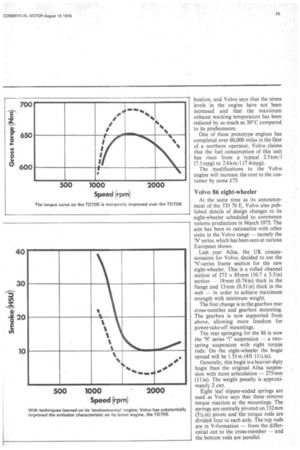The F86 gets a new power unit
Page 26

Page 27

If you've noticed an error in this article please click here to report it so we can fix it.
THE most popular truck in the Volvo range available in the UK — the F86 — is to be fitted with a modified version of the familiar TD 70 engine — the TD 70 E in place of the current TD 70 B European engine and the 70C which is the UK version rated by BSAU 141a.
The new engine retains the same dimensions. However, several detail changes, designed to provide a quieter, cleaner engine, have resulted in a small improvement in power output. Retaining the bore and stroke of its predecessor — 1004.77 x 130 mm (4.125 x 5.12 in) — the engine now produces 150kW (201 bhp) at 2,400 rpm. This compares with the 143kW (192bhp) of the engine it replaces. The maximum torque of 660Nm (487Ibft) occurs at 1,400 rpm.
Many new parts are used in the manufacture of the engine but some will be interchangeable with existing ones. For example, the cylinder block, which has many minor changes, will service all previous TD 70 engines, The major new components are: Cylinder liners; cylinder head assemblers; camshaft; pistons; crankshaft damper; timing cover; turbocharger' fuel-injection system' inlet and exhaust manifolds, A.T. Regulator.
The cylinder liners — of the wet type on the Volvo engine — are corrugated externally to ensure more efficient cooling by increasing the surface area. These corrugations run lengthwise along the liner surface. On the cylinder head dual valve springs are fitted — a feature which Volvo claims will give improved spring life and better performance. New valve collets are used for better retention.
Valve timing
The camshaft has been changed to alter the valve timing. The new geometry involves earlier air intake which, Volvo says, will give better internal cooling by giving the intake charge more time to flow over the piston and liner. On previous designs three compression rings and two oil control rings were fitted — on the TD 70 B only two compression rings are used, with the wall pressures of the existing rings remaining the same. Hopefully, this should reduce engine friction. To suit the new engine torsionals the crankshaft damper characteristics have been modified and the size of the water pump pulley has been altered to increase the coolant flow rate. A higher turbocharger boost is used and, on this engine, an AiResearch unit is fitted for the first time.
The TD 100 and 120 series engines will continue to use equipment from Holset, but the 70 series will standardize on AiResearch. Bosch injection equipment is retained although the plunger size is increased to give a faster injection rate. The injection starts later than the current series but finishes at the same time — in order to reduce noise and improve combustion.
The inlet and exhaust manifolds have been modified to suit the new turbocharger and allow an A.T. regulator to be fitted. In order to ease starting from cold a pre-heating element is fitted to the inlet manifold. This method has been chosen in preference to an excess-fuel device as it avoids the heavy smoke emission normally associated with this type of cold-start device. The A.T, regulator is as used on the Volvo TD 7( D 'environmental' engine and is non included as standard equipment on the E series. It is used, first, as an exhausl brake in fly.: usual manner, but it car also be controlled by the driver tc increase the exhaust back pressure during long periods of idling or durinl engine warm up. This maintains the engine working temperature at a highei level and consequently leads to a cleanei exhaust.
All these changes were carried oul with the intention of improving corn. bustion, and Volvo says that the stress levels in the engine have not been increased and that the maximum exhaust working temperature has been reduced by as much as 30°C compared to its predecessors.
One of these prototype engines has completed over 60,000 miles in the fleet of a northern operator. Volvo claims that the fuel consumption of this unit has risen from a typical 2.5 km/1 (7.1 mpg) to 2.6 km/1 (7,4 mpg).
The modifications to the Volvo engine will increase the cost to the customer by some £75.
Volvo 86 eight-wheeler At the same time as its announcement of the TD 70 E, Volvo also published details of design changes to its eight-wheeler scheduled to commence volume production in March 1975, The aim has been to rationalize with other units in the Volvo range — namely the 'N' series, which has been seen at various European shows.
Last. year Ailsa, the UK concessionaires for Volvo, decided to use the 'N'-series frame section for the new eight-wheeler. This is a rolled channel section of 273 x 85mm (10.7 x 3.3 in) section — 19 mm (0.74 in) thick in the flange and 13mm (0.51 in) thick in the web — in order to achieve maximum strength with minimum weight.
The first change is to the gearbox rear cross-member and gearbox mounting. The gearbox is now supported from above, allowing more freedom for power-take-off mountings.
The rear springing for the 86 is now the 'N' series 'T' suspension — a twospring suspension with eight torque rods. On the eight-wheeler the bogie spread will be 1.51m (4ft 111/4 in).
Generally, this bogie is a heavier-duty bogie than the original Ailsa suspension with more articulation — 275mm (11 in). The weight penalty is approximately 2 cwt.
Eight leaf slipper-ended springs are used as Volvo says that these remove torque reaction at the mountings. The springs are centrally pivoted on 132 mm (51/4 in) pivots and the torque rods are divided four to each axle. The top rods are in V-formation from the differential out to the cross-member — and the bottom rods are parallel.




























































































